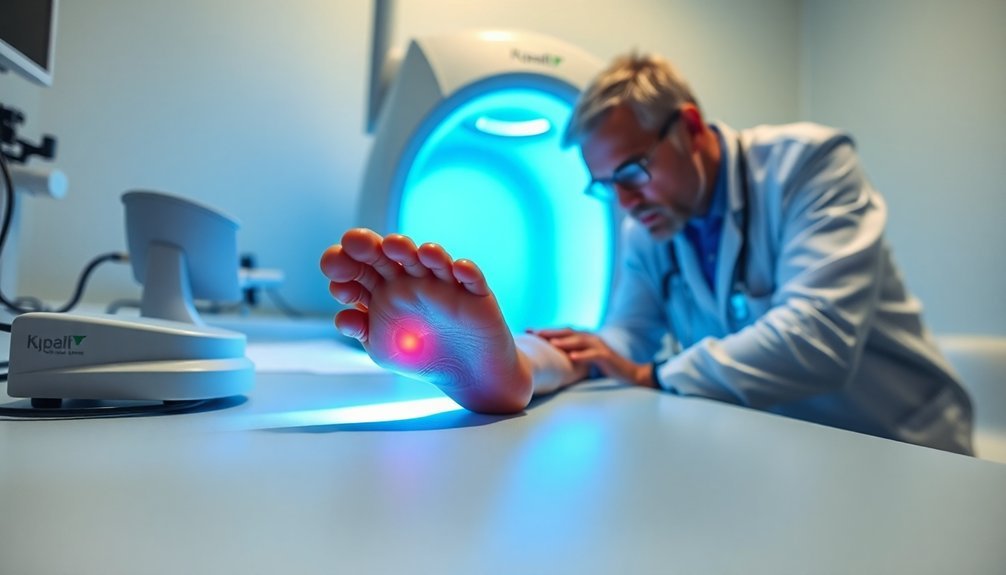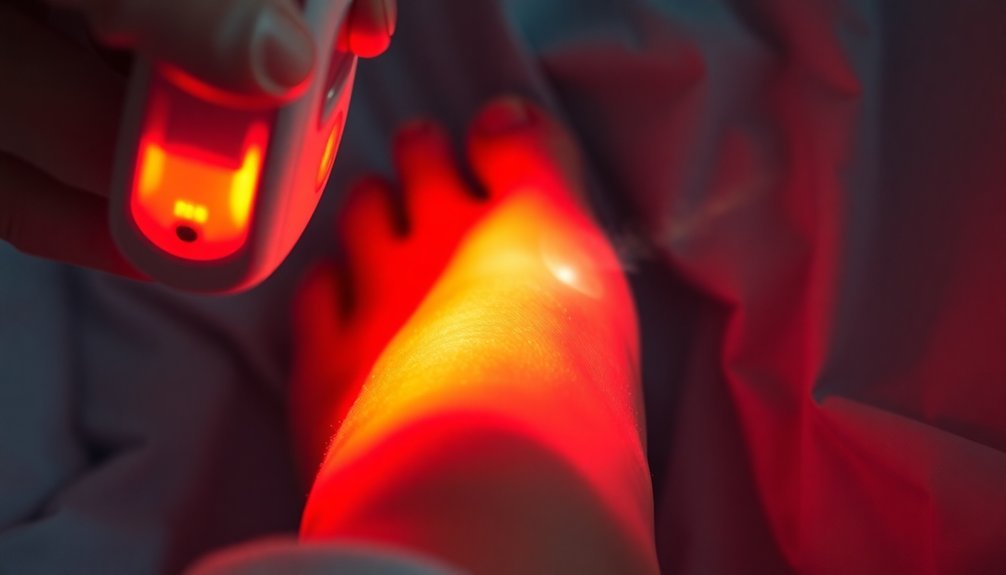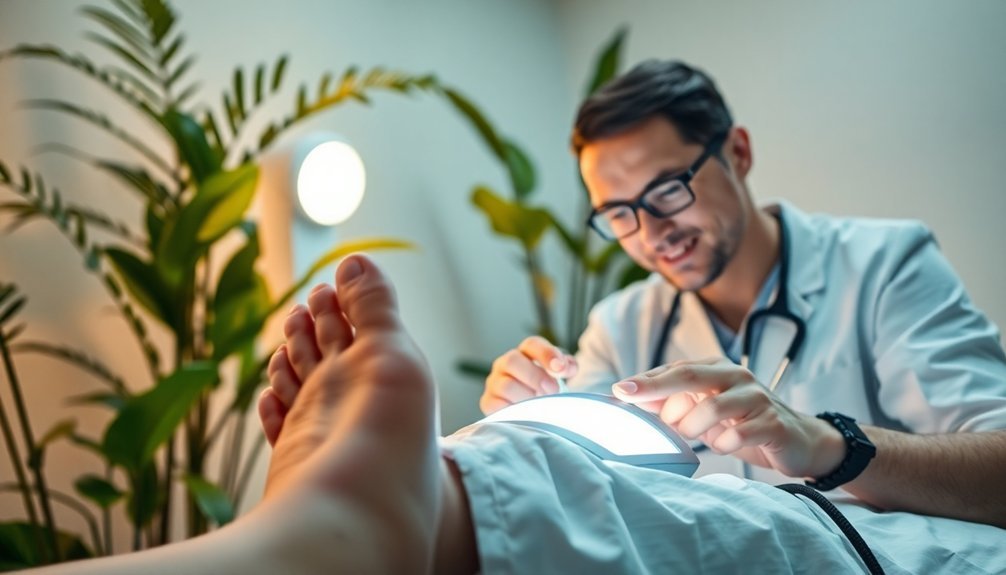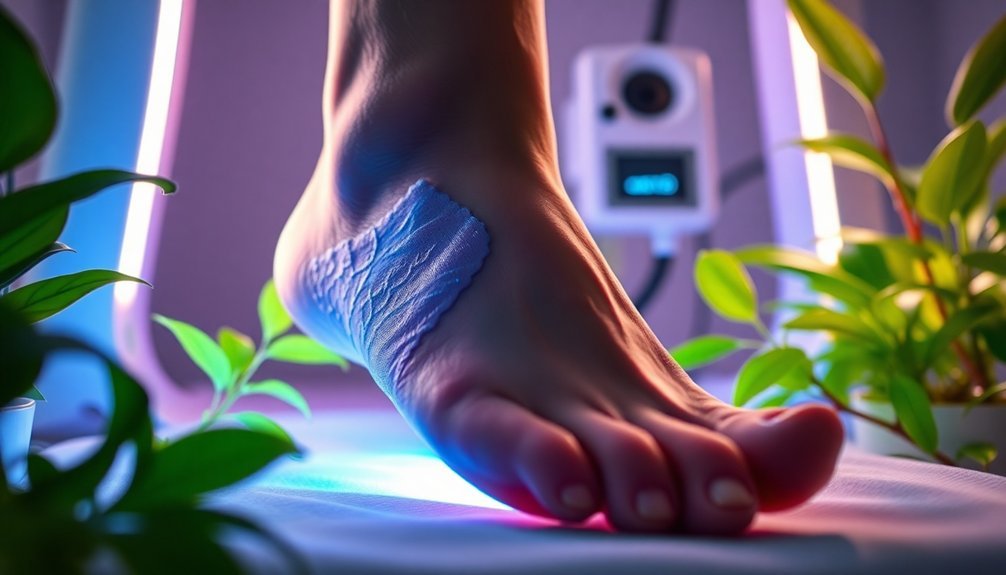If you're looking for effective photobiomodulation treatments for diabetic foot wounds, consider these five options. Blue Light PBM Therapy boosts healing greatly, while Red Light Therapy enhances microcirculation and reduces pain. Infrared PBM Treatment stimulates cell growth, cutting ulcer size dramatically. Combination PBM approaches work even better by integrating stem cells or growth factors. Finally, customized treatment protocols based on specific wavelengths and dosages optimize recovery times. Each option has unique benefits, so exploring them further can really enhance your understanding of how they can help your healing journey.
Blue Light PBM Therapy

Blue light photobiomodulation (PBM) therapy has emerged as a promising treatment for diabetic foot ulcers (DFUs), significantly enhancing healing rates and overall patient outcomes. Research shows that patients receiving blue light PBM experience significant improvements in healing, with many achieving complete closure of their wounds or substantial reductions in ulcer size. This therapy not only accelerates healing but also alleviates pain perception, leading to a better quality of life for you.
The underlying mechanisms of blue light PBM involve increased cellular energy through ATP production, which energizes cells for effective tissue regeneration. It also reduces inflammation and promotes angiogenesis, helping your body form new blood vessels essential for healing chronic ulcers. Additionally, clinical studies support its efficacy; for instance, pilot studies demonstrate better outcomes compared to standard treatments.
Moreover, the safety profile of blue light PBM is encouraging, with no significant increase in adverse events reported. With treatment protocols that typically involve administration twice weekly over several weeks, you'll likely experience a marked improvement in both the ulcers' size and your overall well-being during this therapeutic journey.
Red Light Therapy
Red light therapy can be a transformative treatment option for diabetic foot wounds, utilizing low-power red and near-infrared light to promote healing at a cellular level. By penetrating the skin to a depth of 8 to 10 millimeters, this therapy stimulates cellular energy and boosts the production of adenosine triphosphate (ATP), which is fundamental for repair and regeneration.
Here's what makes red light therapy effective:
- Accelerated Healing: Studies show it markedly reduces wound areas faster than conventional treatments, enhancing granulation tissue and collagen production. In addition, it supports increased cellular energy crucial for combating the slow healing associated with diabetes.
- Pain Relief: It lowers inflammation and pain by modulating pain receptors and releasing endorphins, providing comfort for those suffering from diabetic wounds.
- Improved Microcirculation: The therapy enhances blood flow, delivering essential oxygen and nutrients to the wound site, which is critical for healing.
With minimal side effects and a non-invasive approach, red light therapy is a practical choice.
Adopting this treatment can lead to quicker recovery, reduced pain, and potentially prevent further complications like ulcer recurrence.
Infrared PBM Treatment

Infrared photobiomodulation (PBM) treatment has emerged as a promising approach for effectively managing diabetic foot wounds. This method accelerates wound healing by stimulating fibroblasts, leading to increased cell proliferation, migration, and the release of essential growth factors. Studies reveal considerable ulcer size reductions of up to 30.89% compared to control groups, demonstrating its effectiveness. Additionally, infrared PBM has been shown to significantly reduce oxidative stress in diabetic wounds, further enhancing the healing process.
The ideal parameters for infrared PBM include wavelengths of 808 nm, fluences around 5 J/cm², and power densities between 0.1-0.3 W/cm², with 0.1 W/cm² often yielding the best results. You'll also find that infrared PBM enhances collagen synthesis and promotes angiogenesis, essential processes for robust healing. Plus, it minimizes oxidative stress and pro-inflammatory cytokines, creating an environment that supports healing.
Clinical trials consistently report faster wound contraction, increased granulation tissue formation, and higher complete healing rates with infrared PBM compared to other treatments. Safety is another positive aspect; there's a low risk of side effects or adverse events.
Combination PBM Approaches
Building on the promising results of infrared photobiomodulation (PBM) treatments for diabetic foot wounds, exploring combination PBM approaches offers a new dimension in wound management.
Using a combination of PBM with other therapeutic agents can considerably enhance healing outcomes. Here are a few compelling combinations:
1. PBM and Adipose-Derived Stem Cells (ADS): This combination not only accelerates wound healing but also reduces microbial flora and modulates the inflammatory response effectively.
It enhances angiogenesis and wound strength, leading to improved wound closure rates.
2. PBM and Conditioned Media (CM): By pairing PBM with CM from stem cells, you can achieve substantial anti-inflammatory effects and increased collagen production.
This synergistic influence fosters quicker healing and tissue repair.
3. PBM with Growth Factors**: Integrating PBM with growth factor therapies can boost fibroblast activity**, promoting better migration and release of essential growth factors for healing.
These combination approaches have shown great promise in animal models, and further clinical research could pave the way for innovative treatments in managing diabetic foot wounds effectively.
Customized Treatment Protocols

As you explore customized treatment protocols for diabetic foot wounds, it is essential to take into account factors like wavelength selection, fluence, and treatment frequency, all of which can greatly influence healing outcomes. Tailoring these elements to the individual patient's needs can enhance effectiveness.
| Factor | Recommendations | Effects |
|---|---|---|
| Wavelength | 630-660 nm, 850-890 nm | Promotes fibroblast activity and healing |
| Fluence | 3 J/cm² – 7 J/cm² | ideal wound healing and collagen production |
| Treatment Frequency | 3 times per week or daily for 5-7 days | Accelerates healing time and tissue regeneration |
For ideal results, select wavelengths like 660 nm for enhanced collagen levels, and a fluence of around 4 J/cm², which can limit proteinase activity. Administer treatments regularly, preferably three times a week, to greatly improve wound healing rates. Taking these customized approaches into account allows you to forge a path towards quicker healing and better outcomes for diabetic foot wounds.
Frequently Asked Questions
How Do Different Skin Tones Affect PBM Treatment Outcomes?
Different skin tones affect PBM treatment outcomes by influencing light penetration and energy delivery. Darker skin absorbs more light, which can hinder effectiveness. You'll need tailored protocols for best results across diverse skin tones.
Are There Any Known Side Effects of PBM Therapy?
PBM therapy generally has few side effects, and most reported issues, like headaches or local pain, are mild. You'll find that it's safe, with no significant adverse events or dose-limiting toxicity reported.
How Frequently Should PBM Treatments Be Administered?
You should consider administering PBM treatments daily for ideal healing, especially initially. However, adjusting the frequency to three times a week or bi-weekly can also yield significant improvements based on individual progress and responses.
Can PBM Therapy Be Combined With Other Treatments?
Yes, you can combine PBM therapy with other treatments. Using it alongside conventional methods or biophysical therapies enhances healing, addressing various aspects of recovery. This approach optimizes outcomes, ensuring more effective wound care solutions.
What Long-Term Benefits Can Be Expected From PBM Therapy?
When you use PBM therapy, you can expect long-term benefits like faster healing, reduced ulcer size, improved skin texture, fewer complications, and a lower chance of amputation, enhancing your overall recovery process.
In Summary
To summarize, exploring the various photobiomodulation treatments for diabetic foot wounds can greatly enhance healing. Each option, from blue and red light therapy to infrared treatments, offers unique benefits. By considering combination approaches and customized protocols, you can tailor the treatment to meet your specific needs. Embracing these innovative therapies not only promotes faster recovery but also improves your overall quality of life. So don't hesitate—take the next step toward healing today!





Leave a Reply